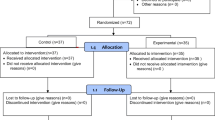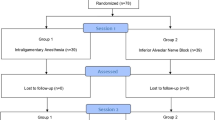Abstract
Objective
The aim of this study was to compare the effectiveness of pain control between a needle-free system and topical anesthesia applied prior to inferior alveolar nerve block (IANB).
Materials and methods
The present study was designed as a randomized controlled cross-over clinical study on 60 children (aged 6 to 12 years) requiring dental treatment with IANB in bilateral mandibular molars. As pre-anesthesia, topical anesthesia (TA) was applied on one side and the Comfort-in™ injection system (CIS) on the other side in two separate sessions before IANB. The injection pain during IANB, at both the needle insertion and solution deposition phases, was analyzed using the Wong-Baker Faces Pain Rating Scale (PRS) and the Face, Legs, Activity, Cry, Consolability Scale (FLACC). The data were analyzed using the Wilcoxon signed-rank test, Spearman correlation, and Mann–Whitney U test.
Results
There were statistically significant differences between TA and CIS in subjective and objective pain evaluations during both the needle insertion and solution deposition. The use of a needle-free system in pre-anesthesia yielded a significant decrease in subjective and objective pain scores (p < 0.001). No statistical difference was found between TA and CIS in terms of patient preference, but patient preference for CIS was significantly higher in older patients (p < 0.01).
Conclusions
It was determined that the use of a needle-free system in pre-anesthesia yielded a decrease in injection pain of IANB.
Clinical relevance
Pediatric dentists should be aware of the new injection system in order to decrease the level of injection pain.




Similar content being viewed by others
References
Shilpapriya M et al (2015) Effectiveness of new vibration delivery system on pain associated with injection of local anesthesia in children. J Indian Soc Pedod Prev Dent 33(3):173–176
Abdelmoniem SA, Mahmoud SA (2016) Comparative evaluation of passive, active, and passive-active distraction techniques on pain perception during local anesthesia administration in children. J Adv Res 7(3):551–556
Pourkazemi M, Erfanparast L, Sheykhgermchi S, Ghanizadeh M (2017) Is inferior alveolar nerve block sufficient for routine dental treatment in 4- to 6-year-old children? Int J Clin Pediatr Dent 10(4):369–372
Kaufman E, Epstein JB, Naveh E, Gorsky M, Gross A, Cohen G (2005) A survey of pain, pressure, and discomfort induced by commonly used oral local anesthesia injections. Anesth Prog 52(4):122–127
Nair M, Gurunathan D (2019) Comparative evaluation of the efficacy of two anesthetic gels (2% lignocaine and 20% benzocaine) in reducing pain during administration of local anesthesia - a randomized controlled trial. J Anaesthesiol Clin Pharmacol 35(1):65–69
Kurien RS, Goswami M, Singh S (2018) Comparative evaluation of anesthetic efficacy of warm, buffered and conventional 2% lignocaine for the success of inferior alveolar nerve block (IANB) in mandibular primary molars: a randomized controlled clinical trial. J Dent Res Dent Clin Dent Prospects 12(2):102–109
Gajendragadkar K, Bhate K, Jagtap B, S.N S, Kshirsagar K, Magoo S (2019) Making inferior alveolar nerve block more comfortable via computer-controlled local anesthetic delivery: a prospective clinical study. J Dent Anesth Pain Med 19(3):135–141
Elbay M, Şermet Elbay Ü, Yıldırım S, Uğurluel C, Kaya C, Baydemir C (2015) Comparison of injection pain caused by the DentalVibe Injection System versus a traditional syringe for inferior alveolar nerve block anaesthesia in paediatric patients. Eur J Paediatr Dent 16(2):123–128
Sandeep V, Kumar M, Jyostna P, Duggi V (2016) Evaluation of 2-stage injection technique in children. Anesth Prog 63(1):3–7
Instruction Manual. Comfort-intm Needle Free Injection System [Internet]. [cited Jan 22 2017]. Available from: http://www.comfort-in. com/file/English-French%20manual.pdf
Kuzin AV (2014) Practical advices in choosing local anesthesia tools in dentistry. Management of carpule's quality in local anesthesia in dentistry. Stomatologiia (Mosk) 93(2):37–39
Wong DL, Baker CM (2001) Smiling faces as anchor for pain intensity scales. Pain 89(2–3):295–300
Willis MH, Merkel SI, Voepel-Lewis T, Malviya S (2003) FLACC behavioral pain assessment scale: a comparison with the child's self-report. Pediatr Nurs 29(3):195–198
Malamed SF (1997) Handbook of local anesthesia, 4th edn. Mosby, St. Louis, pp 149–160
McCartney M, Reader A, Beck M (2007) Injection pain of the inferior alveolar nerve block in patients with irreversible pulpitis. Oral Surg Oral Med Oral Pathol Oral Radiol Endod 104(4):571–575
Fowler S, Crowley C, Drum M, Reader A, Nusstein J, Beck M (2018) Inferior alveolar nerve block injection pain using a computer-controlled local anesthetic device (CCLAD): a prospective. Randomized Study Anesth Prog 65(4):231–236
Nusstein J, Steinkruger G, Reader A, Beck M, Weaver J (2006) The effects of a 2-stage injection technique on inferior alveolar nerve block injection pain. Anesth Prog 53(4):126–130
Jeske AH, Blanton PL (2002) Misconceptions involving dental local anesthesia. Part 2: pharmacology. Tex Dent J 119(4):310–314
Malamed SF (2004) Handbook of local anesthesia, 5th edn. C.V. Mosby, St Louis, Mo, pp 189–226
Arapostathis KN, Dabarakis NN, Coolidge T, Tsirlis A, Kotsanos N (2010) Comparison of acceptance, preference, and efficacy between jet injection INJEX and local infiltration anesthesia in 6 to 11 year old dental patients. Anesth Prog 57(1):3–12
Munshi AK, Hegde A, Bashir N (2001) Clinical evaluation of the efficacy of anesthesia and patient preference using the needle-less jet syringe in pediatric dental practice. J Clin Pediatr Dent 25(2):131–136
Merkel SI, Voepel-Lewis T, Shayevitz JR, Malviya S (1997) The FLACC: a behavioral scale for scoring postoperative pain in young children. Pediatr Nurs 23(3):293–297
Horn SS, Ruggeri A, Pachur T (2016) The development of adaptive decision making: recognition-based inference in children and adolescents. Dev Psychol 52(9):1470–1485
Perez JC, Cumsille P (2012) Adolescent temperament and parental control in the development of the adolescent decision making in a Chilean sample. J Adolesc 35(3):659–669
Shiner R, Caspi A (2003) Personality differences in childhood and adolescence: measurement, development, and consequences. J Child Psychol Psychiatry 44(1):2–32
Merkel S, Malviya S (2000) Pediatric pain, tools, and assessment. J Perianesth Nurs 15(6):408–414
Merkel S, Voepel-Lewis T, Malviya S (2002) Pain assessment in infants and young children: the FLACC scale. Am J Nurs 102(10):55–58
von Baeyer CL (2006) Children's self-reports of pain intensity: scale selection, limitations and interpretation. Pain Res Manag 11(3):157–162
Acknowledgements
The authors do not have any financial interest in the companies whose materials are included in this article.
Funding
The present study was conducted with the resources of the Istanbul Okan University, Istanbul, Turkey.
Author information
Authors and Affiliations
Contributions
Hypothesis and experimental design: SY
Performed the experiments: SY, MT, and MNA
Wrote and proofread the manuscript: SY, MT, and MNA
Corresponding author
Ethics declarations
Conflict of interest
The authors declare that they have no conflict of interest.
Ethical approval
This article reports a study that involved human participants. All the procedures performed in the study involving human participants were in accordance with the ethical standards of the institutional and/or national research committee and with the 1964 Helsinki Declaration and its later amendments or comparable ethical standards.
Informed consent
Informed consent was obtained from all individual participants included in the study.
Additional information
Publisher’s note
Springer Nature remains neutral with regard to jurisdictional claims in published maps and institutional affiliations.
Rights and permissions
About this article
Cite this article
Yıldırım, S., Tokuç, M. & Aydın, M.N. The effect of pre-anesthesia with a needle-free system versus topical anesthesia on injection pain of the inferior alveolar nerve block: a randomized clinical trial. Clin Oral Invest 24, 4355–4361 (2020). https://doi.org/10.1007/s00784-020-03301-9
Received:
Accepted:
Published:
Issue Date:
DOI: https://doi.org/10.1007/s00784-020-03301-9




